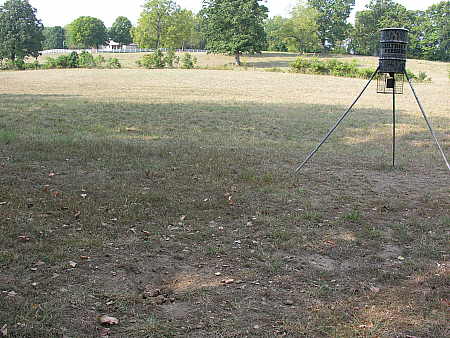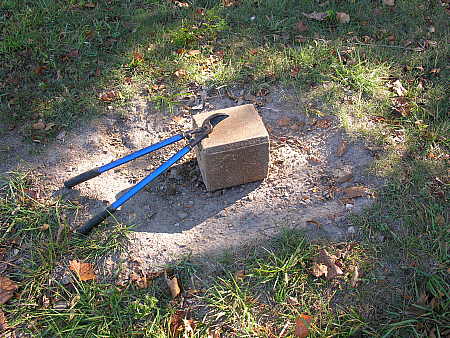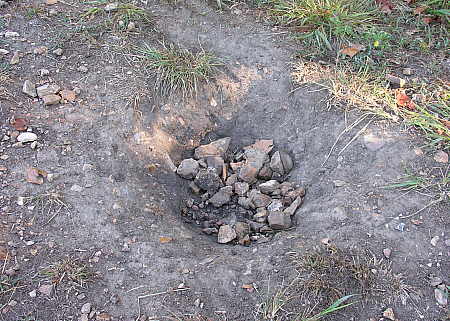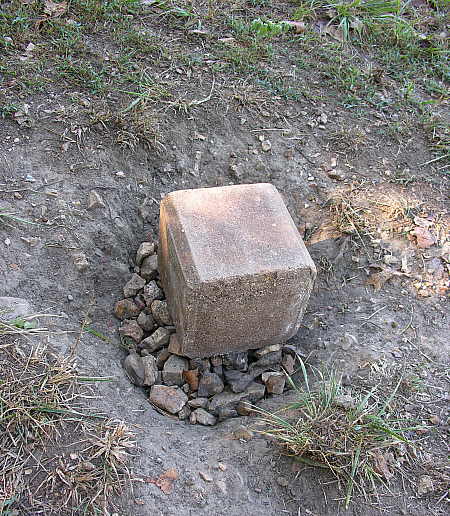
The picture above shows one of the two wildlife feeding stations we have set up along a creek in a field below our house. We have created these sites so that the abundant game that inhabit the area will be attracted to areas where we can see them as we go about our daily routines. The other feeding station, for anyone interested, can be seen in a previous post entitled Birds Of A Feather. You may notice that in the lower left corner of the photo there appears to be a patch of ground that is rock strewn and has been vigorously disturbed in some manner. This is one of the mineral licks that I have established near our feeders.Â

Creating a mineral lick is a simple endeavor. What I like to do after I find a suitable location for the lick is to gather up some downed limbs and build a small bonfire, which clears the area down to bare soil. Then I place a commercially prepared dear and wild game mineral block directly on the soil. Over time, the block will become eroded. Some erosion will have occurred by direct consumption from the area wildlife, but a good portion of the block will simply weather into the ground where it sits. Not to worry – the deer will actually lick the soil in order to get the minerals they crave.

This is what will happen over time. This particular mineral lick was established four years ago. I have decided against filling in the hole each year. Instead, I intend to keep replenishing this site with new mineral block periodically, and observe how large the mineral rich “crater” will grow (it sure beats sitting around watching the grass grow).  The deer have pawed at the ground with their hooves in order to loosen the mineral rich soils, leaving only the Ozarks rocks behind in their wake.Â

The picture above shows how simple it is to replenish the lick. All that is required is to unwrap and toss a new mineral block on top of the pile of rocks that have accumulated in the pit.Â
The mineral blocks contain a variety of essential minerals for deer. Here are some of the ingredients in the blocks I use – salt, magnesium limestone, calcium carbonate, soft rock phosphate (phosphorus), calcium iodate, cobalt carbonate, sodium selenite, ferrous carbonate, ferrous sulfate, iron oxide, manganous oxide, copper sulfate, zinc oxide and lignin sulfonate.
If that weren’t enough to whet the appetite of wild game, the blocks also contain cane molasses and natural apple flavoring. But the real question is this: do these mineral licks do anything for the deer, or am I just spinning my wheels in undertaking this activity? Research seems to indicate that robust antler growth requires a minimum amount of certain minerals, particularly calcium and phosphorus, in the proper ratios (see Mineral Supplementation – Necessity or Never Mind?, by Brad Howard and Brian Murphy). The commercial mineral blocks that are available in any farm supply or feed store are concocted of minerals designed to maximize the potential for antler growth in bucks by supplying the key minerals required for that purpose. In many areas, the soil composition presents sufficient mineral content such that mineral supplements are unnecessary, while in other areas, the soil is lacking in some critical component. To be on the safe side, I have opted to provide supplements for “my” game, just as I also opt to take a multi-vitimin for myself each day.
The fall and winter seasons are the time of year to begin to establish a mineral lick. By establishing the lick at this time, it will be ready and available for use in the spring and summer, when the deer will make the most use of it. And Retta and I will be sitting around, watching the deer take their daily dose of minerals.



I’ve set out a few of these licks in my time, but I’ve always been random about where I’ve put them. Also, I’ve set them on tree stumps and flat rocks. Why do you want to burn away the grass on the ground? Does it interfere with something? Seems like the deer will clear the grass for you.
I’ve also wondered who else might visit one of these. One of mine sure looked like woodpeckers had worked it over pretty hard.
Pablo, I was wondering if someone would ask about that. When we first moved here, I had burned a small pile of limbs, campfire style, which left a scar where it had burned. When I went to establish my first mineral lick, I looked at the barren area and decided to place the mineral block there. Almost immediately, the deer found the block and began using it. While I am pretty sure the prior burning had no effect whatsoever on the successful outcome, I am hesitant to change a procedure that has worked well in the past. It’s just another one of my weird rituals.
Personally, I’d say that even if it weren’t a wonderful addition to the wildlife diet, as long as it isn’t hurting them I’d keep it up. If they enjoy it, and you get to watch them enjoying it, and there is no harm being done to anyone, that is good enough reason for me!
I have one this year … by accident. I had bought a mineral block for a “grow your own stalactites” lab in class last year and I brought the remainder of the block home for the summer.
I set it in the front yard just to get it out of the Jeep and the deer found it immediately. So I left it and now it’s lick sculpture.
Generally when creating a new lick site, the procedure is to clear a 3-4 ft area of any grass, weeds, or foliage. Then rake the area to loosen the soil. The idea behind this is to get the soil loose, so the lick material can bind with the soil quicker to for the lick site. Often the lick material can be in a liquid form or a powder that is mixed with water before applying to the ground. The salt in the lick material will inhibit any growth of vegetation in the lick site, as long as it is kept fresh. From years of use, many of ours look like a small craters.
I have not found anything like this. Like it. what type of soil are u using for lick site?